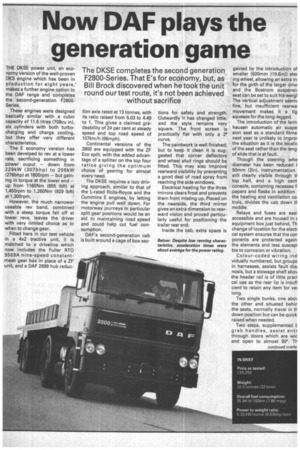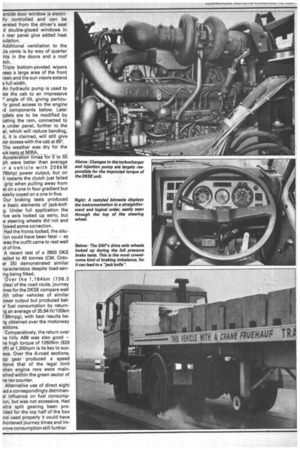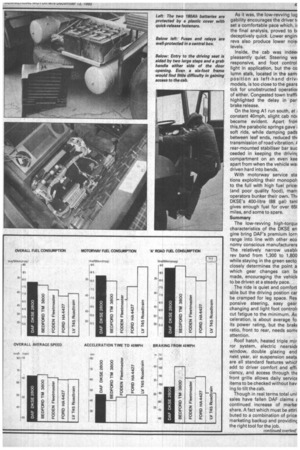Now DAF plays the generation game
Page 47

Page 48

Page 49

If you've noticed an error in this article please click here to report it so we can fix it.
The DKSE completes the second generation F2800-Series. That E's for economy, but, as Bill Brock discovered when he took the unit round our test route, it's not been achieved without sacrifice
THE DKSE power unit, an economy version of the well-proven DKS engine which has been in production for eight years,' makes a further engine option to the DAF range and completes the second-generation F2800Series.
These engines were designed basically similar with a cubic capacity of 11.6 litres (708cu in), six cylinders with both turbocharging and charge cooling, but they offer very different characteristics.
The E economy version has been develped to rev at a lower rate, sacrificing something in power ouput — down from 229kW (307bhp) to 2 06kW (276bhp) at 1800rpm — but gaining in torque at the lower end — up from 1160Nm (855 lbft) at 1,450rpm to 1,260Nm (929 lbft) at 1,300rpm.
However, the much narrower useable rev band, combined with a steep torque fall off at lower revs, leaves the driver with very limited choice as to when to change gear.
Fitted here in our test vehicle in a 4x2 tractive unit, it is matched to a driveline which now includes the Fuller RTO 9509A nine-speed constantmesh gear box in place of a ZF unit, and a DAF 2699 hub reduc
tion axle rated at 13 tonnes, with its ratio raised from 5.03 to 4.49 to 1. This gives a claimed gradea bility of 24 per cent at steady speed and top road speed of 107km/h (66mph).
Continental versions of the 2800 are equipped with the ZF Eco split, with the added advantage of a splitter on the top four ratios giving the optimum choice of gearing for almost every need.
The DKSE requires a lazy driving approach, similar to that of the L-rated Rolls-Royce and the Cummins E engines, by letting the engine pull well down. For motorway journeys in particular split gear positions would be an aid to maintaining road speed and could help cut fuel consumption.
DAF's second-generation cab is built around a cage of box sec
tions for safety and strength. Outwardly it has changed little, and the style remains very square. The front screen is practically flat with only a 2° curve.
The paintwork is well finished, but to keep it clean it is suggested that corner deflectors and wheel stud rings should be fitted. This may also improve rearward visibility by preventing a good deal of road spray from reaching the side windows.
Electrical heating for the three mirrors clears frost and prevents them from misting up. Placed on the nearside, the third mirror gives an extra dimension to rearward vision and proved particularly useful for positioning the trailer rear end.
Inside the cab, extra space is gained by the introduction of smaller (500mm )19.6in)) stet ing wheel, allowing an extra in for the girth of the larger drivt and the Bostrom suspensic seat can be set to suit his weigl The vertical adjustment seemc fine, but insufficient rearwa movement makes it a tig squeeze for the long-legged.
The introduction of the lsrin hausen automatic air suspe sion seat as a standard fitme next year is unlikely to impro) the situation as it is the locatic of the seat rather than the leng of slide that is at fault.
Though the steering whe diameter has been reduced 50mm (2in), instrumentation still clearly visible through tf top half, and a high cent console, containing recesses fl papers and flasks in addition the heating and ventilation co trols, divides the cab down tl middle.
Relays and fuses are easi accessible and are housed in z equipment box just behind. Th change of location for the electi cal system ensures that the con ponents are protected again the elements and less suscepi ble to corrosion or vibration.
Colour-coded wiring ind vidually numbered, but groupe in harnesses, assists fault dies nosis, but a stowage shelf abo% the header rail is of little praci cal use as the rear lip is insufl cient to retain any item for vei long.
Two single bunks, one abo\ the other and situated behir the seats, normally travel in if down position but can be quick raised when needed.
Two steps, supplemented b grab handles, assist entr through doors which are wic and open to almost 90°. Th arside door window is electriIly controlled and can be !erated from the driver's seat
d double-glazed windows in 3 rear panel give added heat 3ulation.
Additional ventilation to the 3ia vents is by way of quarter hts in the doors and a roof tch.
Triple bottom-pivoted wipers teep a large area of the front reen and the sun visors extend e full width.
An hydraulic pump is used to ise the cab to an impressive 1° angle of tilt, giving particu-ly good access to the engine id components below. Later odels are to be modified by cating the ram, connected to e under panel, further to the ar, which will reduce bending, it, it is claimed, will still give ?alaccess with the cab at 65°. The weather was dry for the 3ck tests at MIRA.
Acceleration times for 0 to 50 ph were better than average ir a vehicle with 20 6kW 76bhp) power output, but on ll restarts the clutch just failed grip when pulling away from St on a one in four gradient but easily coped on a one in five. Our braking tests produced e basic elements of jack-knifg. Under full application the lye axle locked up early, but le steering wheels did not and lowed some correction.
Had the fronts locked, the situ:ion could have been fatal — as was the outfit came to rest well ut of line.
A recent test of a 2800 DKS !aded to 40 tonnes (CM, Octoer 25) demonstrated similar naracteristics despite load-senng being fitted.
Over the 1,1 84km (736.3 liles) of the road route, journey mes for the DKSE compare well iith other vehicles of similar ower output but produced betar fuel consumption by returnig an average of 35.94 lit/100km 7.86mpg), with best results be
ig over the motorway ections.
Comparatively, the return over ne hilly A68 was also good — he high torque of 1260Nm (929 aft) at 1,300rpm is its key to sucess. Over the A-road sections, op gear produced a speed ibove that of the legal limit vhen engine revs were mainained within the green sector of ne rev counter.
Alternative use of direct eight lad a correspondingly detrimenal influence on fuel consumpion, but was not excessive. Had !xtra split gearing been pro!Wed for the top half of the box Ind used properly it could have ,hortened journey times and im!rove consumption still further. As it was, the low-revving lug gability encourages the driver t( set a comfortable pace which, it the final analysis, proved to bi deceptively quick. Lower engin' revs also produce lower noisi levels.
Inside, the cab was indeel pleasantly quiet. Steering wa responsive, and foot control. light in application, but the co lumn stalk, located in the sarni position as left-hand drivi models, is too close to the gears tick for unobstructed operatior of either. Congested town traffil highlighted the delay in pani brake release.
On the long Al run south, at i constant 40mph, slight cab no( became evident. Apart frorr this,the parabolic springs gave soft ride, while damping pads between leaf ends, reduced thl transmission of road vibration. rear-mounted stabiliser bar suc ceeded in keeping the drivinc compartment on an even kee apart from when the vehicle war driven hard into bends.
With motorway service sta tions exploiting their monopol■ to the full with high fuel pricer (and poor quality food), man) operators bunker their own. Th( DKSE's 400-litre (88 gal) tanl gives enough fuel for over 65( miles, and some to spare.
Summary The low-revving high-torqu( characteristics of the DKSE en gine bring DAF's premium ham range into line with other eco nomy conscious manufacturers The relatively narrow usabl( rev band from 1,300 to 1,800 while staying in the green secto closely determines the point a which gear changes can 13( made, encouraging the vehick to be driven at a steady pace.
The ride is quiet and comfort able but the driving postion car be cramped for leg space. Res ponsive steering, easy gear changing and light foot control; cut fatigue to the minimum. Ac celeration is about average fo its power rating, but the brakE ratio, front to rear, needs SOME attention.
Roof hatch, heated triple mir ror system, electric nearsidE window, double glazing and net year, air suspension seats are all standard features which add to driver comfort and effi. ciency, and access through the front grille allows daily service items to be checked without hay ing to tilt the cab.
Though in real terms total uni. sales have fallen DAF claims continued increase increase of marke. share. A fact which must be attri buted to a combination of price marketing backup and providinc the right tool for the job.
















































































































